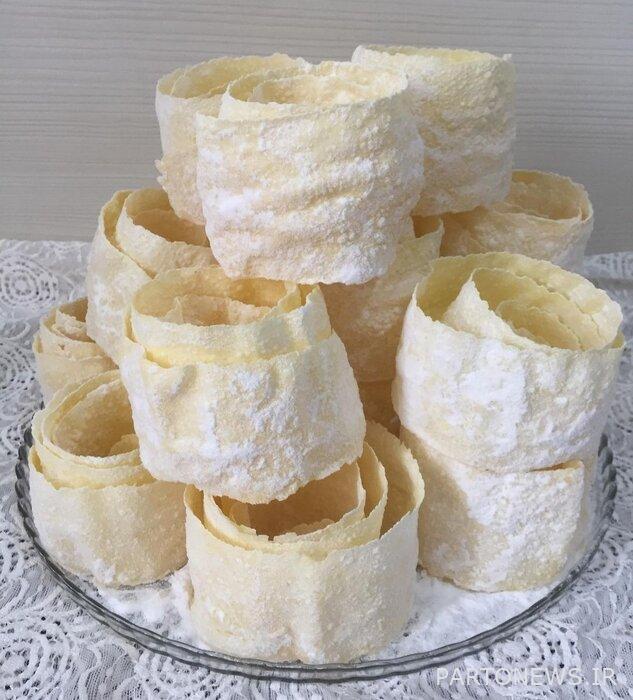Golestan’s traditional sweets, a gift from the residents of the rainbow of the tribes to Nowruz travelers

Along with the pristine nature and historical monuments, Golestan has had a strong place in the hearts of tourists since the distant past with its tasty and fragrant traditional sweets, and these homemade products are one of the attractions of traveling to the rainbow land of ethnicities and religions. One of the most beautiful customs of traveling is buying souvenirs, especially regional foods, so that the good memories will remain in the taste and soul of travelers for a long time.
For a long time, Golestan has had delicious and famous sweets such as walnut halva, Tatari, Padrazi, ginger, pishmeh, Umaj halva, among the seti sweets of Golestan.
In this article you will read:
Kazakhs hosting Nowruz guests with Balqaymaq
Bibi (Shirin), one of the Kazakh residents of Golestan, said: “The Kazakh people spread the table on various holidays and occasions and welcome the guests by preparing traditional sweets. He added: Taleghan, Koresh, Balqaymaq, Bavarsaq and Bosk sweets are prominent on the Kazakh table. And many tourists are applying to buy it. He said: Introducing more traditional sweets as one of the economic capacities of Negarestan Obeen will have a great impact on creating jobs for the residents of Golestan.

Traditional sweets of Gorgan are welcomed throughout the year
Maleeha Shahrabadi, one of the activists of the field of Gorgan pastry making, also said: In our family, the art of baking traditional sweets has been remembered from previous generations, and the production of date, ginger, Sargharbili, Omaj and Padrazi breads is more important to us than others and is welcomed by travelers.
He added: Introducing more traditional sweets has a great impact on attracting tourists and can be the main factor in the desire to travel to a certain region.
Shahrabadi stated: Traditional sweets of Gorgan, due to the use of walnuts and almonds, the variety of cinnamon, cardamom, dates and ginger, lead different tastes to the desired sweets and even have medicinal properties.
He added: Except for Nowruz, Gorgani women and girls prepare these popular sweets throughout the year, and since these sweets are made from high-quality oils, families always want to use them.
Domestic and foreign tourists were well received by traditional Turkmen sweets
One of the activists in the field of Turkmen traditional sweets, Samiyeh Behdoniya told IRNA: “With a lot of effort, we launched the traditional Turkmen sweets baking complex and brought it to the capacity of 300 workers.”
“Ajeh” confectionery group has more than 50 active agencies in Golestan and other provinces. And many people from abroad are requesting to use traditional Turkmen sweets. Referring to about 50 different types of traditional sweets, he said: foreign and domestic tourists from local sweets, such as Tatar Churg flour sweets, Pashmeh. Qadlameh, Shaq Shaqi, traditional sesame chocolate, traditional walnut kasmak. Creamy pirashki and walnut qatab are very popular and they prepare these products as souvenirs.
He stated: Turkmen women and girls are producing and selling traditional home-made sweets in their homes following the example of the Aja collection, and they play a role in improving the economic status of their families.

Tatar sweets are the heritage of Qazalbash people
Shahrbanu Memshli, who was known as Shahrbanu’s aunt in Minodasht city, says in this connection: I learned to bake Tatari bread from my ancestors and I have been baking Tatari bread for more than 25 years and I have many customers from surrounding cities.
He added: Many people introduced their friends and relatives after they became customers of Tatari bread, and this has led to the prosperity and introduction of this local dessert of the Qezelbash people.
He said: I have tried to revive the sweets of my people for many years in my house, but if Tatari bread baking workshops are opened at the present time. It has the ability to be sent to different cities and provinces of the country and will undoubtedly generate high employment.
Shaherbanu’s aunt said: Tatar bread and baking of this sweet is displayed in every house of the Qazalbash people for a week during Eid. And with the smell of this sweet, it becomes the smell of Eid in their guest houses.

Remarkable reception of travelers from Bandargaz and Kordkoi walnut halva
Motaher Khaki is one of the confectioners who is trying to revive the traditional Bandargaz walnut halwa sweet and introduce it to travelers. Tourists and the young generation have put in a lot of effort, he told IRNA: About 20 years ago, near Nowruz, I put a few pieces of walnut halva in the window of the shop, along with modern and non-native sweets, which was well received by travelers. And after that, every year, we produce this traditional sweet in different and high-quality packages.
He stated: Revival of baking walnut halva, or “Aghuz halva” and “black halva” has had a great impact on the region’s economy. And many women, men, girls and boys cook this sweet and sell it in shops and confectioneries.

The special place of Sistani sweets in the souvenir basket of travelers
Mohammad Azari, head of Nimroz Foundation, also told IRNA: “Sistani people use a variety of sweets on various occasions and celebrations, including Zabali date cookies, Tejgi, Katlameh, sugar cookies, Sistani ginger cookies, and Kharmalendo.”
Dates, wheat and various spices have been widely used in Sistan since ancient times, and their use in sweets has been welcomed by many people.
In most provinces of the country, including Golestan, Zablei date cookies are used. But most people don’t know that this famous cookie is a traditional sweet of the Sistani people.
Due to the raw materials, strength and attractiveness of Sistani sweets among students and the wide acceptance of these sweets, the production of this product on a wide scale has the potential to create many jobs. As the souvenir basket of every traveler and tourist has one of these traditional sweets of the Sistani people, special attention should be paid to this matter.


